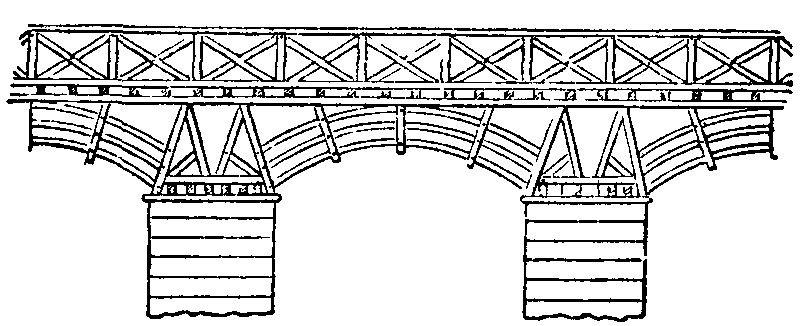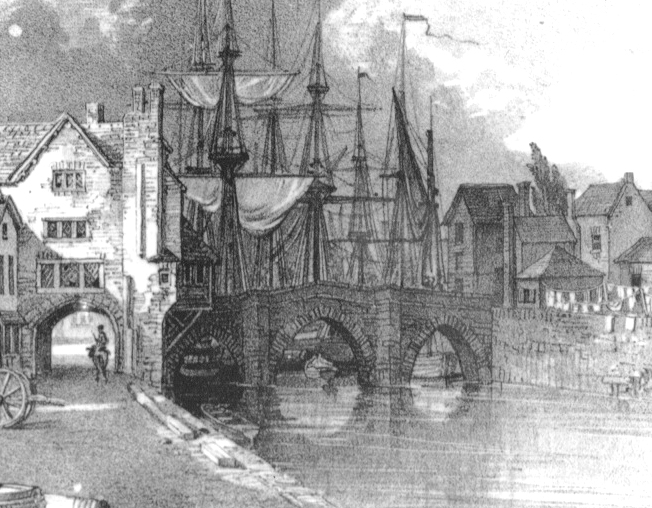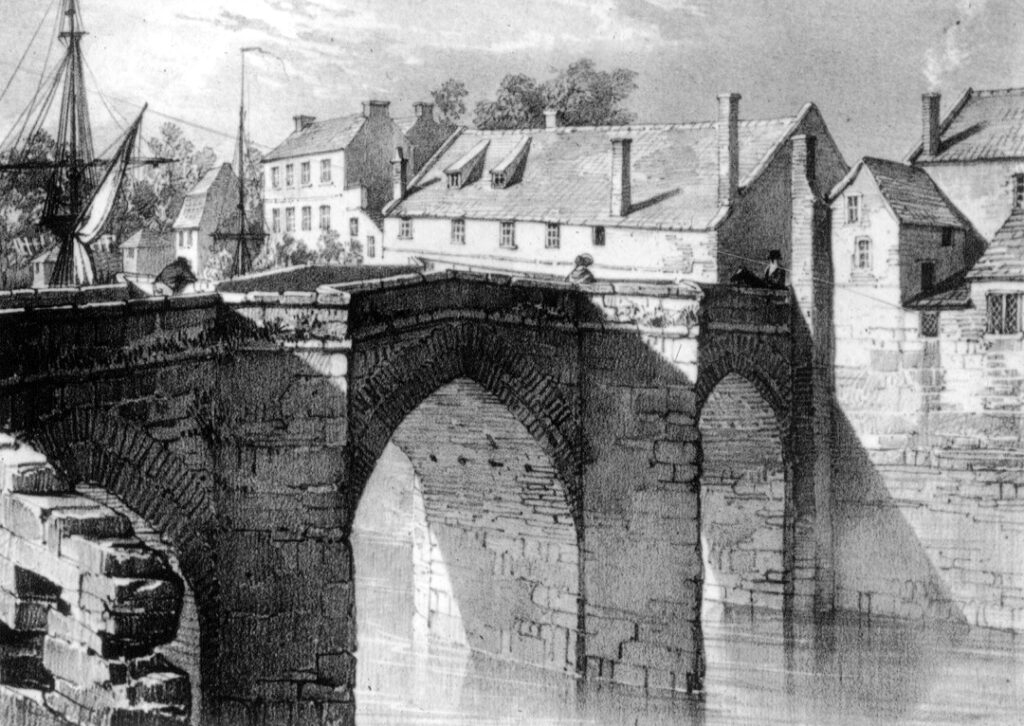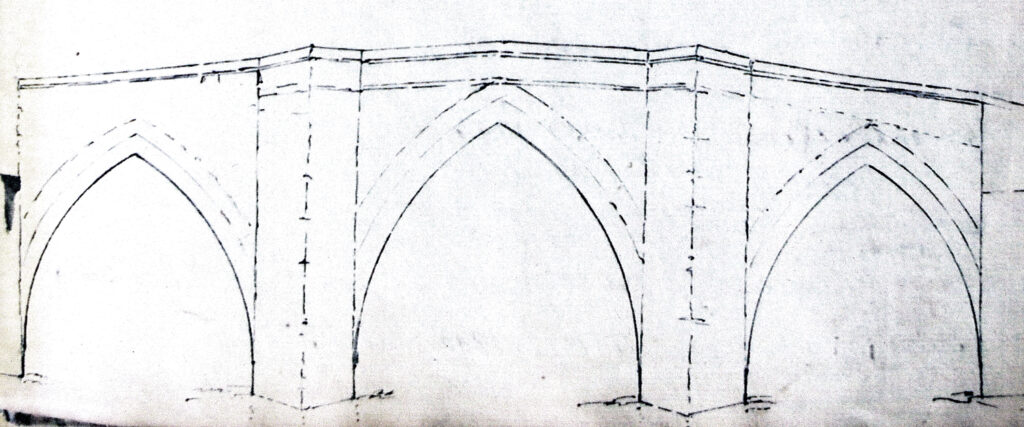Before the Stone Bridge: an Anglo-Saxon Bridge?
It is difficult to say with any confidence when the very first bridge of Bridgwater was constructed, let alone a stone bridge. Although there long existed a fording point over the river at Combwich at low tide, a bridge would have been very desirable to help with east-west communication through Somerset.
The earliest piece of evidence for a bridge in Bridgwater comes from the first element of the name, ‘Bridg’, first recorded in the Domesday Book of the 1086, Brugie (the second element, ‘Walter’, being added later). The opinion of historians is divided on the meaning of the ‘Bridg’ element of the name Bridgwater. At face value it seems to just mean bridge. However, in the Victoria County History for Somerset, Dunning suggests that the name may derive from either the Norse word for quay or the Old English for gangplank, his assumption that the town grew from a quayside, rather thana river crossing. This can certainly be contested. For a start, we are very unlikely to find a Norse settlement name in the heartlands of Anglo-Saxon Wessex. Meanwhile, in Old English the name is much more likely to refer to bridge, rather than gangplank. In several early Latin documents relating to the town the name was often translated to ‘Pons Walteri’, Pons being the Latin word for bridge.
Even if we settle on bridge meaning bridge in this instance, we are still not in the clear. Harrison’s Bridges of Medieval England asserts that old English word ‘bridge’ could mean as little as a mere man-made improvement to a natural river crossing, rather than anything more substantial, meaning we still might not expect a full permanent structure that would keep your feet dry when going over the Parrett. However, we may infer the existence of something substantial in Anglo-Saxon times. Given the settlement was just known as ‘the Bridge’ with no modifiers, it suggests it was important enough not to need any modifiers – when referring to the bridge in this area everyone knew exactly what was meant. Second, given the huge tidal range of the River Parrett, and the destructive force of the tidal boar, it is hard to imagine how any structure that bridged the Parrett in any meaningful way could not have been a piece of significant and costly engineering. Given what is known about the sophistication of the later Anglo-Saxon military and its infrastructure, we might imagine the first bridge of Bridgwater to have been a substantial undertaking to allow the easy movement of the army.
The Stone Bridge
Mentions in later centuries suggest that a bridge was constructed by William Briwerre, the man who founded Bridgwater as a town and built the large castle in about the year 1200. While Briwerre was spending large sums building a mighty castle and employing skilled workers to construct it, it would seem likely that he would have a bridge built as part of the scheme. The bridge would be the last easy crossing point on the River Parrett before the sea (save for the fording point at Combwich, which could only be used at low tide) and also as far inland as sea traffic could go, meaning all goods would have to be unloaded at Bridgwater. Both road and river traffic could thence be charged for the privilege and Briwerre would have a lucrative earner. In the foundation charter for Bridgwater, Briwerre was granted the right of pontage, the levying of tolls on crossing a bridge. In the fifteenth century tolls were charged in loaded carts crossing the bridge, suggesting that unladed carts and pedestrians could pass free of charge.
It is likely that Briwerre’s bridge consisted of two large piers, known as ‘cutwaters’, set into the bottom of the riverbed, upon which a timber roadway spanned the gaps. The bridge required regular repairs, and the town possessed a common fund to pay for these, such was the bridge’s importance. A condition of being a burgess of Bridwater, set down in the Ordinance of the Burgesses in the thirteenth century, was to ensure the upkeep of the bridge. By 1286 the structure was known as ‘the Great Bridge’, possibly to distinguish it from the bridges over the town ditch at the four gates.

The sixteenth-century antiquarian John Leland reported that locally the bridge was attributed as being started by Briwerre and completed by John Trivet. In 1395 Trivet gave three hundred merks (£200, a merk being 2/3 of one pound) for improving the bridge and work was completed in 1400. This phase probably saw the addition of the three stone arches to the bridge, replacing the wooden roadway. Harrison’s study of medieval bridges suggests it was usual that thirteenth-century stone pier-and-timber-crossing bridges would be completed with stone arches in the fifteenth century.

Almost a hundred years after Trivett’s modifications, in 1584-5 the bridge had fallen into a poor state of repair, due to the action of the tides, as well as the constant traffic of military vehicles (presumably carts laden with weapons and heavy cannons).
There are mentions of at least three tenements on the bridge. Whether they were literally built onto the bridge or were just very close nearby is unclear, although the latter is much more likely. It was certainly not unusual to find houses, shops and even chapels built on the top of medieval bridges, although Bridgwater’s bridge was probably too narrow to support such structures. There is also a brief mention of a chapel on the bridge, served by the Franciscan Friars, although sadly we do not know more of this feature. Medieval bridge chapels can be seen at St Ives in Cambridgeshire and Rotherham, these ones being built atop and enlarged bridge pier. Again, the bridge in Bridgwater would probably have been too small for a chapel to have been built onto it, but one of the adjoining buildings built onto the end of the bridge may have served as a chapel.
The Bridge that Trivett paid to be completed was recorded by Chubb in the 1790s. It once bore the Trivett arms on the side, although these were not apparent on Chubb’s paintings. It is possible they were removed along with the whole central arch of the bridge during the Civil Wars in the 1640s. During the Storm of Bridgwater in 1645 there is a mention of there being a drawbridge at the bridge. This has usually been taken to suggest that one of the arches of the bridge had been removed and replaced with drawbridge. The arch was presumably then rebuilt after the wars.

An Act of Parliament was granted in 1794 for the town to build a new bridge and to extend the quays. The stone bridge was removed in 1795 when a new iron bridge was constructed, the forerunner of the bridge of today (built in 1883). It proved difficult to remove the old stone cutwaters and they remained for a number of years as convenient moorings for ships undergoing repairs.

The above sketch of the bridge was made in February 1794, not long before it was demolished. This picture was taken from Somerset Heritage Centre D/B/bw/2418 (part of the Bridgwater Borough Archives collection) – unfortunately the exact reference has not yet been found among the papers of the Bridgwater Borough Archives. This is accompanied by a survey of the bridge:
Middle arch broad: 24ft
Each side arch: 20ft 6; both 41ft
Piers each: 8ft 9; both 17ft 6in
River between the Buttresses: 82ft 6in
Road between the walls: 12ft
Wall 1ft 10 in each; 3ft 8in, with road: 15ft 8in
Piers project each 6.9; 13ft 6in
Extent from north to south 29ft 2in
From the top of the parapet (in the middle of the bridge) to the foot path: 3ft 9in
From the footpath to the crown of the centre arch: 3ft 2in
From the crown of the centre arch to low water: 22ft 10 1/2 in
From low water to the bed of the river: 5ft 10 1/2 in
Whole height from bed of the river to top of the wall: 35ft 8in
From the quay (by the old crane) to low water: 16ft 9in
How do you build a medieval bridge?
See this video of the construction of the Charles IV bridge in Prague:
References
Harrison, The Bridges of Medieval England, (2004)
Lawrence, History of Bridgwater, (2005)
Powell, Bridgwater in the Later Days, (1908)
Dilks, Bridgwater Borough Archives 1200-1377, (1933)
Leland, Itinerary, Chandler, J., ed. (1998)
Sprigge, Anglia Rediviva (1647)
